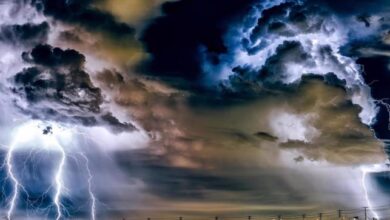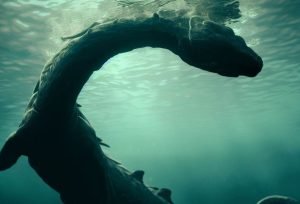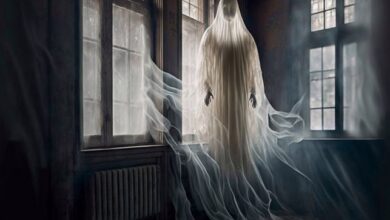NASA Warns of an “Invisible Monster” on the Loose in the Universe

It is rarely a good thing when a news report announces there is a monster on the loose. It is even worse if the report says the monster is invisible. And it’s downright terrifying of the source cited for this invisible monster report is NASA. The agency issued a press release and the opening sentence is “There’s an invisible monster on the loose.” Should we check with the newly announced Artemis II astronauts to see if they can fit one or two more people in the capsule?
“There’s an invisible monster on the loose, barreling through intergalactic space so fast that if it were in our solar system, it could travel from Earth to the Moon in 14 minutes.”
Speaking of going to the Moon, that is exactly the example NASA gives for how fast the invisible monster is traveling – a speed that would get the astronauts into lunar orbit almost as fast as Mission Control can say, “Please fasten your seatbelts and turn off all electronic devices.” But NASA is our brave version of a “boldly go where no human has gone before” organization. What is the “invisible monster” and why does it sound as if NASA fears it? Should we be afraid as well?
“This supermassive black hole, weighing as much as 20 million Suns, has left behind a never-before-seen 200,000-light-year-long “contrail” of newborn stars, twice the diameter of our Milky Way galaxy. It’s likely the result of a rare, bizarre game of galactic billiards among three massive black holes.”
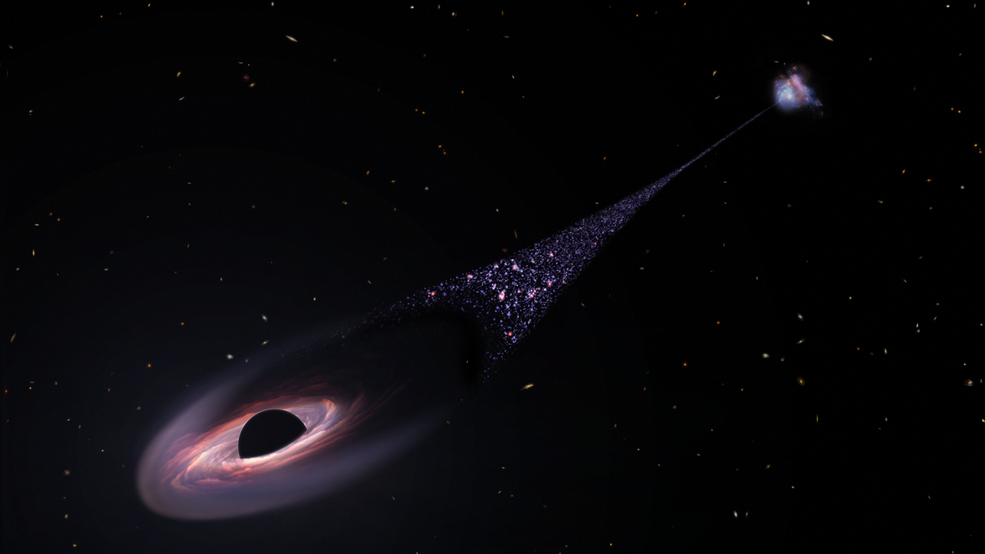
This is an artist’s impression of a runaway supermassive black hole that was ejected from its host galaxy as a result of a tussle between it and two other black holes. As the black hole plows through intergalactic space it compresses tenuous gas in front to it. This precipitates the birth of hot blue stars. Credits: NASA, ESA, Leah Hustak (STScI)
“A rare, bizarre game of galactic billiards among three massive black holes” sounds more like something fun to watch – not an “invisible monster”. And most galaxies have at least on supermassive black hole (including our own Milky Way) and NASA has never called one an “invisible monster” before. Why this one?
“Rather than gobbling up stars ahead of it, like a cosmic Pac-Man, the speedy black hole is plowing into gas in front of it to trigger new star formation along a narrow corridor. The black hole is streaking too fast to take time for a snack. Nothing like it has ever been seen before, but it was captured accidentally by NASA’s Hubble Space Telescope.”
There you go with the fun game reference again, NASA. If you want us to be concerned or fearful, Pac Man is not the video game to use in your warning. However, this part of the press release is finally getting close to why this supermassive black hole is such a big deal. First, it was a surprise. (Way to go, Hubble – you’ve still got it!) Second, it is not consuming stars but creating them – the trail it is leaving behind is the visible sign of this otherwise “invisible monster.”
“We think we’re seeing a wake behind the black hole where the gas cools and is able to form stars. So, we’re looking at star formation trailing the black hole. What we’re seeing is the aftermath. Like the wake behind a ship we’re seeing the wake behind the black hole.”
Pieter van Dokkum, an astronomer at Yale University and lead author in the new paper on the “invisible monster”, explains that what Hubble accidently picked up in layperson’s terms is a runaway supermassive black hole. That plus its size is what likely gives it the “monster” part of NASA’s description. Van Dokkum says his team was so shocked by this rogue supermassive black hole that it took another look using the W. M. Keck Observatories in Hawaii. With that spectronomy, the astronomers determined that visible portion of what Hubble saw was the aftermath of a black hole flying through a halo of gas surrounding the host galaxy. They were able to estimate that the massive collision which spawned this monster began 50 million years ago when two galaxies merged and their central supermassive black holes created a binary black hole. Another galaxy collided with this merged pair and found that in space, “two’s company and three’s a crowd.” (There you go with the funny references again, NASA.) The three black holes formed “a chaotic and unstable configuration” which eventually threw one black hole out around 39 million years ago. That appears to be the star-forming, invisible monster of the announcement.
“The line ratios, colors, and overall morphology are consistent with an ejected SMBH (supermassive black hole ) moving through the CGM (circumgalactic medium) at a high speed while triggering star formation.”
What about the binary black hole it left behind? The astronomers feel confident that Hubble captured a photo of that too.
“Opposite the primary wake is a fainter and shorter feature, marginally detected only in [O iii] and the rest-frame far-ultraviolet. This feature may be shocked gas behind a binary SMBH that was ejected at the same time as the SMBH that produced the primary wake.”
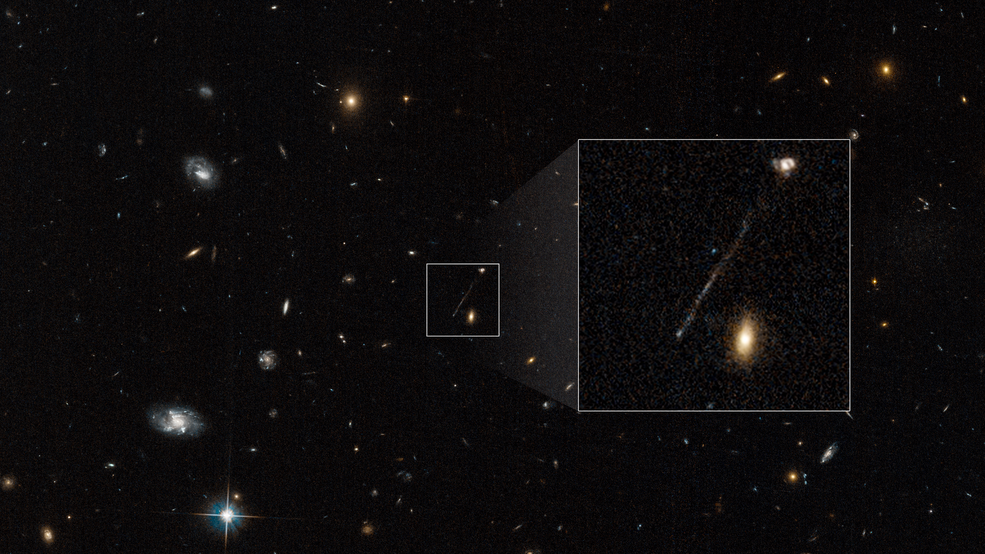
So, the “invisible monster” left a lot of visible newborn stars and shocked gas in its wake, allowing astronomers to ‘see’ the invisible monster-supermassive black hole careening through the universe. That brings up the final question: Where is it and should we be worried that we could become the next galactic billiard ball?
“But don’t worry, luckily this beast is very, very far away!”
That’s the best the press release can do … the exact location of the invisible monster SMBH is buried somewhere in the scientific jumble of numbers in the paper. However, it still throws in one more scary reference – “beast.” Why has NASA decided to use such colorful and often horror movie-ish references to this obviously impressive new discovery? (It also issued a video to go along with the press release.) Will this become a new trend in NASA announcements? Will the discovering of rogue black holes, strange signals, galactic collisions and the like begin to sound like an astronomical lineup of college football mascots or Marvel comics villains? That might not be a bad idea, since most papers published about such discoveries are dry and scientific. The photos from the new James Webb Space Telescope show how adding a little bit of color enhancement and clarity can get many more people excited about astronomy. Perhaps some verbal enhancement can do the same thing.
For now, we’ll go with the “invisible monster” that is the “serendipitous discovery of a remarkable linear feature in Hubble Space Telescope (HST) images that we suggest may represent such an SMBH-induced wake.” Kudos to NASA and especially to the still-relevant Hubble telescope.

